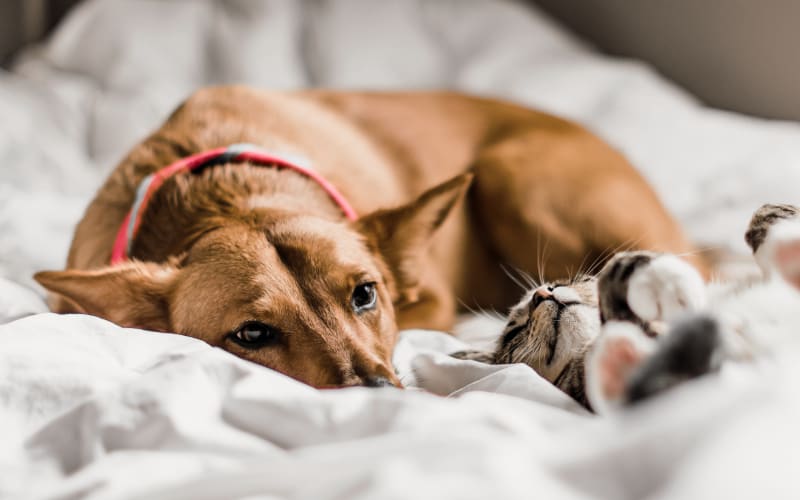
Veterinary Surgeon for Brooklyn's Pets
We offer a variety of veterinary surgical procedures at both of our Brooklyn clinics. Our team performs these services using only the most stringent protocols.
During each surgery, a dedicated nurse will administer anesthesia and continuously monitor your pet using electronic patient monitoring equipment. Your pet will also be provided with ongoing pain management under the supervision of our team.
Post-operative monitoring and care are our priorities following surgery. Your vet will ensure that you have all of the information needed to continue caring for your pet once you are at home.
Surgical Consent Form
If your pet has an upcoming surgery at one of our locations, please complete the online form in advance of the procedure.
Veterinary Surgery Services in Brooklyn
Our veterinary team routinely performs many different types of surgery from preventive care procedures to surgeries to help treat various conditions and diseases.
Our vets at Heart of Brooklyn Veterinary Hospital routinely perform the following elective and non-elective surgeries:
-
Dental Surgery
Our veterinarians provide dental surgeries for dogs and cats. These surgeries can range from tooth extractions to gum disease treatment and jaw fracture repairs.
-
Spaying & Neutering
When we spay or neuter a cat or dog, we are surgically sterilizing them in order to protect them from a variety or potentially fatal conditions as well as helping to control the pet population.
-
Soft Tissue Surgery
For pets experiencing disorders that affect the ears, nose or throat, we offer soft tissue surgical procedures.
These procedures can also be performed for hepatic, urogenital, oncological, cardiothoracic, gastrointestinal, and skin disorders.
-
Mass Removal
Cats and dogs can develop masses associated with the skin. Masses can also grow inside a body cavity and can be serious or life-threatening.
Our vets in Brooklyn commonly perform mass removal surgeries for pets in the area. -
Foreign Body Removal
It is possible for your dogs or cats to get an object stuck inside their body either through play or with an injury.
Whether your pet has eaten an object they shouldn't have or an accident has left them injured, we can perform foreign body surgery to remove it.
In some cases, specialized skills or equipment are needed to perform pet surgery. If that is the case for your animal, your vet will refer you to a cat or dog surgeon near Brooklyn and work closely with your veterinary surgeon to ensure that your dog or cat receives the very best care. -
Wound Repair
Wounds occur when living tissue has been cut, broken, burnt, torn, or otherwise damaged.
It's imperative that these wounds be cleaned, disinfected, and appropriately cared for by a qualified veterinarian as soon as possible.If they are not tended to quickly they hold the possibility of becoming infected and causing further complications.
The Veterinary Surgery Process
We understand that the prospect of bringing your pet in for surgery can be frightening. Please be assured that we recommend surgery only when it is in the best interests of your furry companion.
We will ensure that you fully understand why we are recommending surgery and that you are comfortable making the decision to move ahead.
If your pet requires specialized care outside of what we can offer, our vets will refer you to a veterinary surgeon near Brooklyn, and work with that veterinary specialist to ensure that your pet continues to receive care specific to their needs.
Surgical Protocols at Our Clinic
Our team practices stringent surgical protocols at our veterinary clinics, including:
- Pre-surgical assessments
- Dedicated surgical suites
- Sterile surgical attire
- Sterile packs and equipment
-
Soft Tissue Surgery
At Heart of Brooklyn Veterinary Hospital, we provide a comprehensive range of soft tissue surgical procedures for our cat and dog patients in Brooklyn. Soft Tissue Surgical Procedures We offer soft tissue surgical procedures for dogs and cats suffering from ear, nose and throat disorders, ...Read more » -
Spaying & Neutering
Spaying and neutering are common surgeries performed at our Brooklyn animal clinic that help to control the unwanted animal population and offer a number of health benefits to cats and dogs. Getting Your Pet Fixed At Heart of Brooklyn Veterinary Hospital, our team understands that making t...Read more » -
Veterinary Dental Care & Surgery in Brooklyn
At Heart of Brooklyn Veterinary Hospital, our veterinary team provides dental cleaning, exams and surgical services for Brooklyn pets to help prevent and treat oral health issues. Oral Health For Dogs & Cats Routine dental care can help to preserve your pet's oral health, yet preventiv...Read more »
